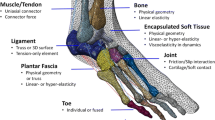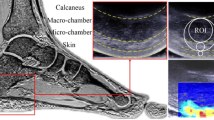Abstract
The primary objective of conservative care for the diabetic foot is to protect the foot from excessive pressures. Pressure reduction and redistribution may be achieved by designing and fabricating orthotic devices based on foot structure, tissue mechanics, and external loads on the diabetic foot. The purpose of this paper is to describe the process used for the development of patient-specific mathematical models of the second and third rays of the foot, their solution by the finite element method, and their sensitivity to model parameters and assumptions. We hypothesized that the least complex model to capture the pressure distribution in the region of the metatarsal heads would include the bony structure segmented as toe, metatarsal and support, with cartilage between the bones, plantar fascia and soft tissue. To check the hypothesis, several models were constructed with different levels of details. The process of numerical simulation is comprised of three constituent parts: model definition, numerical solution and prediction. In this paper the main considerations relating model selection and computation of approximate solutions by the finite element method are considered. The fit of forefoot plantar pressures estimated using the FEA models and those explicitly tested were good as evidenced by high Pearson correlations (r = 0.70–0.98) and small bias and dispersion. We concluded that incorporating bone support, metatarsal and toes with linear material properties, tendon and fascia with linear material properties, soft tissue with nonlinear material properties, is sufficient for the determination of the pressure distribution in the metatarsal head region in the push-off position, both barefoot and with shoe and total contact insert. Patient-specific examples are presented.








Similar content being viewed by others
Abbreviations
- CT:
-
Computed tomography
- DM:
-
Diabetes mellitus
- DOF:
-
Degrees of freedom
- FEA:
-
Finite element analysis
- FEM:
-
Finite element method
- SXCT:
-
Spiral X-ray computed tomography
- TCI:
-
Total contact insert
References
Boulton A, Betts R, Franks C et al (1987) Abnormalities of foot pressure in early diabetic neuropathy. Diabet Med 4:225–228
Pecoraro R, Reiber G, Burgess EM (1990) Pathways to diabetic limb amputation. Basis for prevention. Diabet Care 13(5):513–521
Edmonds M, Blundell M, Morris M et al (1986) Improved survival of the diabetic foot: the role of a specialized foot clinic. Q J Med 60(232):763–771
Chantelau E, Haage P (1994) An audit of cushioned diabetic footwear: relation to patient compliance. Diabet Med 11(1):114–116
Mueller M, Diamond J, Sinacore D et al (1989) Total contact casting in treatment of diabetic plantar ulcers. Controlled clinical trial. Diabetes Care 12(6):384–388
Sinacore D (1996) Total contact casting for diabetic neuropathic ulcers. Phys Ther 76:296–301
Brand P (1983) The diabetic foot. In: Ellenberg M, Rifkin H (eds) Diabetes mellitus: theory and practice. Medical Examimation Publishing, New Hyde Park, pp 829–849
Ctercteko G, Dhanendran M, Hutton W, Le Quesne L (1981) Vertical forces acting on the feet of diabetic patients with neuropathic ulceration. Br J Surg 68(9):608–614
Mueller M, Hastings M, Commean P et al (2003) Forefoot structural predictors of plantar pressures during walking in people with diabetes and peripheral neuropathy. J Biomech 36:1009–1017
Holewski J, Moss K, Stess R et al (1989) Prevalence of foot pathology and lower extremity complications in a diabetic outpatient clinic. J Rehabil Res Dev 26: 35–44
Gefen A (2003) Plantar soft tissue loading under the medial metatarsals in the standing diabetic foot. Med Eng Phys 25:491–499
Lemmon D, Shiang TY, Hashmi A, Ulbrecht JS, Cavanagh PR (1997) The effect of insoles in therapeutic footwear–a finite element approach. J Biomech 30:615–620
Lemmon DR, Cavanagh PR (1997) Finite element modeling of plantar pressure beneath the second ray with flexor muscle loading. Clin Biomech 12 (13)
Gefen A, Megido-Ravid M, Itzchak Y, Arcan M (2000) Biomechanical analysis of the three-dimensional foot structure during gait: a basic tool for clinical applications. J Biomech Eng 122:630–639
Thomas VJ, Patil KM, Radhakrishnan S (2004) Three-dimensional stress analysis for the mechanics of plantar ulcers in diabetic neuropathy. Med Biol Eng Comput 42:230–235
Chen WP, Tang FT, Ju CW (2001) Stress distribution of the foot during mid-stance to push-off in barefoot gate: a 3-D finite element analysis. Clin Biomech 16:614–620
Cheung JT, Zhang M (2005) A 3dimensional finite element model of the human foot and ankle for insole design. Arch Phys Med Rehabil 86:353–358
Szabo BA, Babuska I (1991) Finite element analysis. Wiley, New York
Commean PK, Mueller MJ, Smith KE, Hastings M, Klaesner J, Pilgram T, Robertson DD (2002) Reliability and validity for combined imaging and pressure assessment methods for diabetic feet. Arch Phys Med Rehabil 83(4):497–505
Commean PK, Mueller MJ, Smith KE, Hastings M, Klaesner J, Pilgram T, Robertson DD (2002) Reliability and validity of combined imaging and pressures assessment methods for diabetic feet. Arch Phys Med Rehabil 83:497–505
Kelly VE, Mueller MJ, Sinacore DR (2000) Timing of peak plantar pressure during the stance phase of walking. A study of patients with diabetes mellitus and transmetatarsal amputation. J Am Podiatr Med Assoc 90:18–23
Robb RA, Barillot C (1989) Interactive display and analysis of 3-D medical images. IEEE Trans Med Imaging 8(3):217–226
Mueller MJ, Strube MJ (1996) Generalizability of in-shoe peak pressure measures using the F-scan system. Clin Biomech 11:159–164
Hastings MK, Commean PK, Smith KE, Pilgram TK, Mueller MJ (2003) Aligning anatomical structure from spiral X-ray computed tomography with plantar pressure data. Clin Biomech 18:877–882
Jacob S, Patil MK (1999) Stress analysis in three-dimensional foot models of normal and diabetic neuropathy. Front Med Biol Eng 9:211–227
Yamada H (1970) Strength of biological materials. William & Wilkins Company, Baltimore
Gefen A (2003) The in vivo elastic properties of the plantar fascia during the contact phase of walking. Foot Ankle Int 24:238–244
Klaesner JW, Commean PK, Hastings MK, Zou D, Mueller MJ (2001) Accuracy and reliability testing of a portable soft tissue indentor. IEEE Trans Neural Syst Rehabil Eng 9:232–240
StressCheck V7.0, Advanced topics guide, ESRD, Inc., St. Louis, MO, 2005
Gefen A (2001) Stress analysis of the standing foot following surgical fascia release. J Biomech 35:629–637
Jacob S, Patil MK (1999) Three-dimensional foot modeling and analysis of stresses in normal and early stage Hansen’s disease with muscle paralysis. J Rehabil Res Dev 36:252–263
D’Andrea SE, Thompson D, Cao D, Davis B (1999) Finite element modeling of load transmission through the Calcaneus. 23rd annual meeting of the American Society of Biomechanics. Pittsburgh
Klaesner JW, Hastings MK, Zou D, Lewis C, Mueller MJ (2002) Plantar tissue stiffness in patients with diabetes mellitus and peripheral neuropathy. Arch Phys Med Rehabil 83:1796–1801
Bland JM, Altman DG (1986) Statistical methods for assessing agreement between two methods of clinical measurements. Lancet i: 307–310
Erdemir A, Saucerman JJ, Lemon D, Loppnow B, Turso B, Ulbretch JS, Cavanagh PR (2005) Local pressure relief in therapeutic footwear: design guidelines from finite element models. J Biomech 38:1798–1806
Acknowledgments
We acknowledge funding from NCMRR, NIH, RO1 HD 36895. We also acknowledge the Prevention and Control Research Core of the Washington University Diabetes Research and Training Center (P60 DK 20579) for their assistance in subject recruitment.
Author information
Authors and Affiliations
Corresponding author
Rights and permissions
About this article
Cite this article
Actis, R.L., Ventura, L.B., Smith, K.E. et al. Numerical simulation of the plantar pressure distribution in the diabetic foot during the push-off stance. Med Bio Eng Comput 44, 653–663 (2006). https://doi.org/10.1007/s11517-006-0078-5
Received:
Accepted:
Published:
Issue Date:
DOI: https://doi.org/10.1007/s11517-006-0078-5




